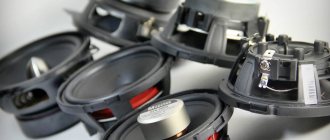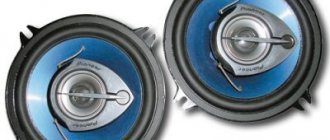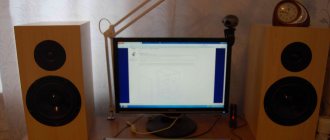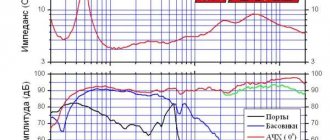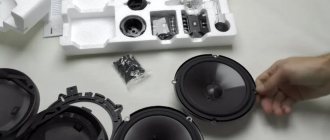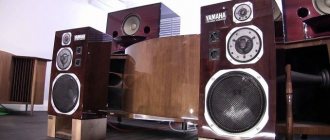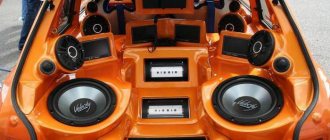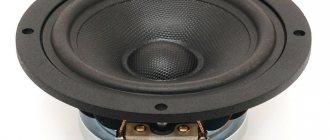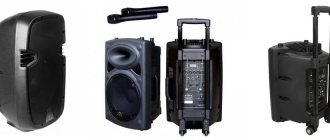Before you decide to purchase and install “pop” acoustics on your car, you need to know the differences between professional and component speakers.
Ultimately, it is this information that will help you make a choice in favor of one or another equipment necessary to create a car sound system.
Differences between “stage and components”:
- Sensitivity. Since pop speakers are classified as professional musical equipment, they have a higher sensitivity. Dynamic mid-range, high-frequency and low-frequency speakers have a wider range of reproducible frequencies.
- Sound power and frequency. Here, too, the “stage” wins over the components. The thing is that professional speakers are combined into a three-way speaker system, where each component operates only at frequencies that are “comfortable for itself” and does not reproduce frequencies beyond its capabilities. Thanks to this, the sound is quite clear and loud. With component speakers, as the volume increases, the sound quality deteriorates significantly. Strong distortions and wheezing appear.
- Dimensions and weight. Component speakers win here. They generally have standard dimensions, making them compatible for installation in many vehicles, and are lightweight (due to the use of a paper diffuser). As for the “stage,” a diffuser made of polypropylene is used here, a heavier material than paper. However, it is more waterproof. Well, the non-standard dimensions of pop speakers (16 cm and 20 cm, respectively) significantly complicate the process of self-installation of such systems in a car.
Interesting! Many car enthusiasts equip their vehicles with pop-up acoustic systems, expecting high-quality sound. However, such speakers are designed to be listened to at a certain distance from them.
Cost of pop speakers
The cost of pop speakers is slightly higher than the price that sellers ask for component acoustic speakers. This is due, first of all, to the higher quality of the sound output (although in order to feel truly high-quality sound, you need to listen to such speakers at a certain distance).
Also, more durable materials (for example, a polypropylene diffuser) and greater power also influence the final pricing factors.
To truly experience the difference between component and variety car speakers, you need to use the highest quality music files. Highly compressed formats will not work here. The ideal solution would be to listen to audio files in FLAC format. The only disadvantages include the high size of one such file.
Budget variety speakers for cars
Variety speakers for a car are not a cheap pleasure. However, there are many companies on the market that produce professional acoustics at an affordable price. So, when choosing car speakers, you should pay attention to the following models regarding budget variety speakers in cars:
ACV ST-38.1PRO
Horn speaker operating at high frequencies. The rated power is 150 W, and the peak power is 300 W. Maximum operating nominal resistance is 4 ohms.
The average cost is 1500 rubles.
ACV SV-165PRO
A mid-frequency speaker with a rated power of 150 W and a maximum power of 300 W. Resistance 4 Ohms. Has a high pass filter: 200Hz 12dB/OKT.
Estimated cost 4000 rubles.
Alphard Hannibal HLG-25NEO
The tweeters have a maximum power of 80 Watts, and a nominal power of 40 Watts. They operate in the frequency range from 2000 to 20000 Hz. Coil resistance – 4 Ohms. Sensitivity – 106 dB.
Estimated cost 4000 rubles. The set is supplied in two copies.
Criteria for choosing audio speakers for a car
When choosing car speakers, you need to pay attention to the following parameters:
Dimensions
10-13 centimeter models are excellent for installation in standard installation locations for acoustics. 16, 17, 20 cm options “give out” clean and deep bass, but the high-frequency speakers should have a small diameter, thanks to this, high notes will sound clean and high-quality.
Electric power indicator
It is important to ensure that the electrical power of the speakers is only slightly higher than the output power of the audio device from which the music is being played.
- The rated power indicated on the speakers indicates the indicator at which the equipment can operate for a long time without overheating the coil and destroying the diffuser suspension.
- The maximum power indicates all the capabilities of the speaker.
- Without consequences, the equipment can withstand only a short period of peak load.
Sensitivity
When choosing speakers, it is important to pay attention to sensitivity and resonant frequency (Fs), as well as overall quality factor (Qts). The sensitivity indicator of the equipment is 84 -86, indicating that without an additional amplification device, the speakers are not used.
The lower the Fs parameter, the richer and deeper the bass produced by the speakers. The Qts parameter is responsible for high frequencies. The higher this indicator, the better.
Results
In conclusion, it is worth noting that professional acoustics are sold already adapted for installation on a car. The speakers are equipped with the necessary elements for connecting to the radio, included in the kit with the equipment itself. In addition, they are equipped with fastenings that allow them to be installed directly in the car.
However, it is important to remember that professional acoustics are an order of magnitude more expensive than the components, and there is much more “fuss” with installation and connection.
- To achieve high sound quality, you should listen to music in high quality formats (not every radio tape recorder supports such formats, and you will need much more space to store such musical compositions).
- If you listen in Mp3 format, then other than an increase in volume, you won’t be able to detect any differences from using component audio systems.
What is the difference between 2-way and 3-way speakers?
Three-way speakers are different
from two-way speaker systems in that each emitter has its own frequency. The presence of an additional speaker expands the direction of sound waves, making the composition sound more realistic.
Interesting materials:
How many moves in chess are there before there is a draw? How long are tests stored? How long do homemade truffles last? How long do cooked eggs last? How long do shelled walnuts last? How long do eggs last at room temperature? How long do ointments last? How long do opened Cream House in the Village last? How long are letters stored in email? How long do vacuum-packed foods last without refrigeration?
How do pop audio systems differ from classic ones?
How do pop audio systems differ from classic ones? And to do this, you need to understand what kind of audio system you want to get, and clearly understand its purpose - to work inside the car (classic audio system) or in an open space (pop audio system).
How are classic car audio systems built?
“Classic” audio systems got their name for a reason. The principles of their construction are in many ways similar to the principles of good home stereo systems. They are designed to create the highest quality and comfortable sound for those inside the car.
One of the criteria for sound quality is the sound stage, and it is with this that the main problems occur in a car. Let's briefly explain what it is and why soundstage is so important. Any stereo recording contains spatial information. For example, if you sit in front of a stereo system at home, you will hear that the sound is not just coming from the speakers, but filling the space between the left and right speakers. And if you listen to, for example, a concert recording, you can easily hear where the musicians were during the recording or how the sound engineer “placed” them - in the center, to the left, to the right, further, closer. The “sound space” recreated in this way is the sound stage. If the audio system is able to convey it correctly, you begin to listen to music fully, and not just as a set of sounds that add up to a melody.
In order for the audio system to correctly form the sound stage, it is necessary to place the speakers in front of the listeners and try to move them as far forward as possible, as far as the cabin configuration allows. This is necessary so that the relative difference in distances to the right and left is minimal. If you can’t do this (and to put it bluntly, this is fundamentally impossible in a car), then you can “even out” this difference in distances virtually – using delays. This feature is available in sound processors, so if you have one in your audio system (whether separate, built into the head unit or in the amplifier), this gives you additional benefits.
Of course, we haven’t forgotten about rear speakers; in many cases they can be useful. However, one should not overestimate its role. The task of the rear is only to complement the main (front) acoustics and provide it with a slight “backup” to create surround sound. Rear acoustics should not draw attention to themselves.
The subwoofer can also be placed in the trunk, since at lower frequencies there is no longer a propagating sound wave in the car, but the so-called “compression” principle works - the diffuser compresses and decompresses the air throughout the cabin, much like a piston in a cylinder. Therefore, if the subwoofer is made competently and with high quality, and the system is configured correctly, the bass is not localized at the back, but sounds integral, is part of the music, its sound does not “peel off” from the sound of the speaker systems.
How are variety car audio systems built?
As in the case of classic audio systems, the term “variety” also appeared for a reason. Such audio systems are built according to the same principles as various types of stage concert audio monitors. Unlike the “classics”, they belong to the “far field” acoustic systems. Their task is to work in large spaces, and it is assumed that listeners should be at some distance from them.
Since stage systems must provide a sufficiently high level of undistorted volume, it is logical to build them in the form of large arrays of speakers. Such arrays can be located, for example, in doors, in the trunk of a car, and even in the form of “walls”. The fashion for the latter originated in South America, which is why they are often called “Brazilian walls.”
Why is listening to a variety system inside a car wrong?
Making a variety system to listen to inside the car is not the best solution. Firstly, the volume reserve provokes you to turn up the volume knob harder on your favorite track, and too high a volume leads to a decrease in the conductivity of the auditory nerve, and this, unfortunately, is an irreversible degradation of our hearing, up to its complete loss.
Secondly, with large arrays of speakers in the doors, it is fundamentally impossible to achieve high-quality sound inside the car. Sitting in a car, you find yourself surrounded by speakers, and in this situation, at a minimum, you have to forget about the correct sound stage. And that's not all.
The ideal sound source is a point source, that is, when the sound comes from one point. In classical systems, single speakers are placed on the left and right, each of which reproduces its own frequency range. In pop systems, we are dealing with arrays of identical speakers. And when some of them are closer, others are further, sound waves simultaneously reach the listeners, having traveled different distances, and therefore shifted relative to each other in phase. Our hearing is very sensitive to such phase distortions; as a result, the sound loses its naturalness, and the music simply turns into a collection of loud sounds.
If you want to get a universal system that can be listened to inside the car and used as a stage system, the best solution is to make it double. In the cabin you install classic speakers and arrange them according to classical principles, and, for example, in the trunk you install “variety” components - you will turn them on only when you decide to arrange open-air.
How do speakers for pop systems differ from regular ones?
The first and most important difference is the extremely high sensitivity of the pop speakers. This parameter characterizes the efficiency of the speaker. In other words, with the same supplied power, stage speakers can sound much louder. This is achieved by various technological and design solutions, but, as always, when winning in one thing, you have to sacrifice something. For example, pop speakers for the most part do not know how to work effectively in the mid-bass range, which is responsible for the density and impact of sound (below 200-250 Hz).
The fact is that the lower the frequency, the greater the volume of air that needs to be “moved” by the dynamics to obtain the same volume. And this can be done only in two ways - either increase the area of the diffuser, or increase its stroke, or use a special acoustic design (for example, bass reflex). For obvious reasons, car speakers are limited in size, as well as in design, since pop arrays are most often located in the doors. Therefore, the diffuser stroke remains a decisive factor. But this is precisely the limiting factor in pop speakers.
As a result, the vast majority of pop speakers operate effectively at mid frequencies and do not have very high output at lower frequencies. But a system operating in the “far field” can be configured so that the frequency ranges responsible for the density and “impact” of sound will be reproduced by the subwoofer. What kind of subwoofer should be for this is a separate question.
If we put pop speakers into a classical system, then we will no longer be able to assign these frequency ranges to the subwoofer. While in the car, we will clearly hear that the subwoofer is located in the back. The bass will no longer be an integral part of the music and will sound on its own. This, by the way, is another reason why listening to a variety system inside a car is bad manners.
How to choose speakers for an audio system?
At first glance, these two rules sound banal and obvious, but we see many audio systems that did not live up to the expectations of their owners for one simple reason - they did not follow them.
First, clearly and clearly decide on the purpose of your future audio system - will it be a “far-field” system or will you listen to it exclusively inside the car. The first will work great in an open space, and the second will provide sufficient volume and high sound quality during daily trips.
Secondly, select speakers according to the chosen concept. Pop speakers are for a pop system, classic speakers are for a classical system. Do not use stage speakers for a classic system, you will not get the expected sound quality. Conversely, classic speakers are usually not efficient enough for use on the stage - most likely you will not get the expected volume.
If you want versatility, make a double system, separate classical and pop acoustics.
Any attempt to do the opposite and combine two-in-one will result in unnecessary compromises, ineffective use of the speaker's capabilities and, in most cases, disappointment and wasted money. So do everything right and you will get great results. Return to list
FakeHeader
Comments 20
Stage! Alphard! ask the most deaf people in the city, they will confirm!
Thank you for your competent answer, everything is accessible and understandable
I know this for sure only in general terms))) that’s why I’m interested
LF, HF. Midrange - everyone plays their own frequency range. Subs play somewhere around 15-60 hertz, midbass play 90 Hz-10 kHz, tweeters play 2 kHz-25 kHz. Wideband speakers play somewhere from 50 Hz to 10 kHz. Although different speakers do it differently. Accordingly, each speaker is cut to a certain frequency. For example, I don’t have 60-100 Hz. Although this is not so noticeable, because... They play for me not for quality, but for volume.
and what is the difference, well, in the sense that what are midbass, woofers, broadband speakers, etc. for?
the frequency that the dynes pass through! tweeters (tweeters) are in the upper frequency range, mids are low-mid frequencies, and wideband speakers, as their name suggests, play the high frequency range
Yes, it’s too early to buy something, I need to read a little theory =)
yes yes, I noticed that too, I’m still in favor of auto components))
Thanks, the stage is an excellent option, but which amplifier would be better?
4-channel cadence or dragster. They are around 6000-8000
The question is, if you take a stage, will you need crossovers for it and which ones are better to take? and how to connect it, it’s usually 8 ohm
Types of dynamic columns
The acoustic system consists of dynamic heads. They are divided into low-frequency, mid-frequency and high-frequency. Let's take a closer look at how different types of columns differ:
Low Frequencies
Speakers that reproduce exclusively low frequencies are called woofers. They are responsible for the band from 40–60 Hz to 800–1000 Hz, and have an average sensitivity of 86–90 dB. Low-frequency speakers are necessary to “rock” the room.
Mid frequencies
Midrange speakers are considered the most important element in a speaker system. Even without bass and treble, you can hear vocals and basic musical instruments. Such speakers reproduce a band in the range from 250–350 Hz to 6000–7000 Hz with a sensitivity of 89–93 dB.
Which acoustics should you give preference to when choosing - coaxial or component?
Choosing acoustics for a car is a question that is difficult to answer unequivocally. It all depends on many factors.
Coaxial acoustics are characterized by their simplicity of design and trouble-free installation. Due to their relatively low cost, most people prefer these speakers. If you want to get good sound, it is better to give preference to models from the middle and high price segment. Typically, they have additional filters that provide clear sound.
Component acoustics are considered a more advanced option; they are preferred by true music lovers who are very demanding of sound transmission and value power, purity and richness of sound. The design feature allows you to implement different options and adjust sound reproduction. If you are willing to pay more for quality, then you should give preference to component acoustics.
What speakers are best to put in the car?
The main thing when choosing car acoustics is to decide on its type.
The type is determined, in general terms, by a combination of price, quality and dimensions. There are 3 of them. It cannot be said that there is definitely the best and definitely the worst; rather, they have different use cases.
- Component
- Coaxial
- Broadband
Component speakers for the car
Component car speakers offer the best sound quality, but also a fairly high price . Component speaker sets usually consist of several speakers. Or, to paraphrase, several stripes.
Component speaker logic: separate speakers for different frequency ranges . That is, one emitter is responsible for the low frequency, a second for the midrange, and a third for the high frequency. But most often you can find two-way systems on the market.
The most common type - it is also the minimum for building a component system - is a speaker (usually a midrange or midbass, however, these concepts are often synonymous) and a tweeter (“tweeter”) . In addition to them, the kit must include a crossover that allows you to adjust the frequency separation.
If there are 2 emitters, then the three main sound bands (LF, MF and HF) must be divided into 2. The proportions depend on the manufacturer, crossover and settings.
Component speakers, which is logical, take up quite a lot of space in a car . After all, you need to place several speakers. But it is precisely such a system that, when properly installed and configured, will give the best sound. Ideally, these are not only the front doors and tweeters, but also the rear and subwoofer.
Coaxial car speakers
Coaxial speakers in a car are coaxial emitters installed in one housing . That is, there is a bass (most often mid-bass) speaker, and mid-range or high-frequency emitters are installed directly on it, instead of a cap.
This arrangement of drivers is a great space saver . But the sound quality, with other comparable parameters, will be worse in comparison with component acoustics. The main difference is that coaxial speakers will not give such a natural scene.
Building a high-quality imaginary scene inside a car is an almost impossible task. After all, the listener is not at all in the center, relative to the emitters. This can be solved by delay settings on the amplifier or radio, but, whatever one may say, these are “crutches”.
All of the above does not mean that coaxial speakers are a bad choice . There are very worthy models that provide excellent sound for the money. For most car audio lovers (those for whom it is not enough to simply listen to the radio from a standard system, but for whom audiophile delights are also alien), this type can be considered the first to be considered.
Main differences from component systems
Before purchasing car or home acoustics, you need to know the differences between stage and component systems. This is the only way you can understand which device is suitable for your car. Concert speakers cost significantly more than modular ones. This is due to higher power and sensitivity. So, here are the main differences between pop acoustics and component ones:
- The main difference is that stage acoustics have a high level of sensitivity. Stage speakers focus on sound volume rather than detail. They are used in auditoriums where maximum output volume is required, i.e. at public events or in clubs. Conventional coaxial or component speakers in most cases are not capable of delivering a high level of sensitivity. More precisely, as the volume increases, strong sound distortion appears. The sensitivity of average component speakers is 90–95 dB, while for stage systems this figure is at the level of 100–110 dB and higher.
- Wide frequency range and huge potential for personalization. Stage audio systems include three main dynamic heads: low-frequency (from 40–60 Hz to 800–1000 Hz with a sensitivity of 86–90 dB), mid-frequency (from 250–350 Hz to 6000–7000 Hz with a sensitivity of 89–93 dB) and high-frequency (from 1500–2500 Hz to 20000–30000 Hz with sensitivity 90–93 dB). There are also subwoofers, midbass and wideband speakers. In this case, each of the elements is responsible for its own segment of the frequency range. The crossover creates the necessary conditions for playback, cutting off unnecessary frequencies for each emitter. This allows for wider scene coverage and balanced sound. Also, such a system has great potential for customizing and improving the sound to suit your needs.
- Dimensions and weight. As a rule, modular speaker systems are lightweight and have standard dimensions. This allows you to easily install them in the car interior. Stage speakers have more non-standard dimensions, so installation takes longer.
